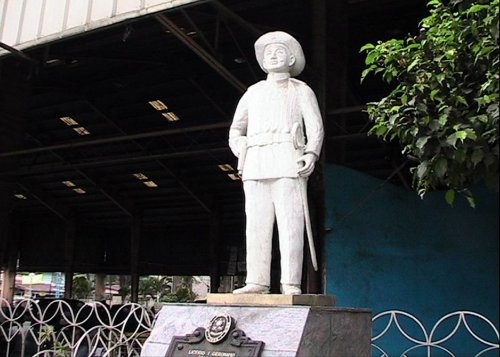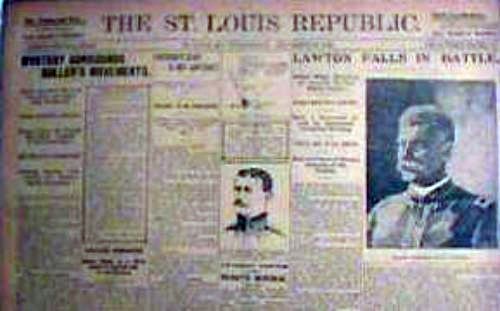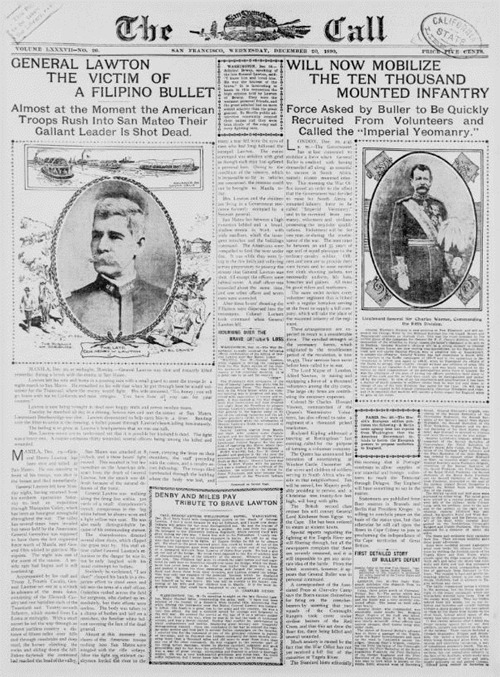Dec. 19, 1899: General Henry Lawton dies at San Mateo
Maj. Gen. Henry W. Lawton was the highest-ranking U.S. military officer to be killed in action in the Philippine-American War. He was the only general awarded the Medal of Honor during the American Civil War to die in combat and the first serving general killed outside of North America.
He was born on March 17, 1843 in Manhattan, Ohio. He received the Medal of Honor for heroism at Atlanta on Aug. 3, 1864 during the US Civil War. In the spring of 1886, he led US troops into Mexico in pursuit of the Apache Chief, Geronimo, who surrendered on Sept. 3, 1886.
When the Spanish American War broke out in 1898, Lawton was sent to Cuba in command of the 2nd division of the 5th Army Corps, distinguishing himself in El Caney and backed up Teddy Roosevelt and his Rough Riders in their charge on San Juan Hill.
However, he was tormented by chronic depression and alcoholism. After smashing the interior of a saloon and personally assaulting the local police chief, Lawton quietly returned home. The government fabricated a cover story of tropical illness. His career potentially in ruins, he begged President McKinley for a second chance.
On Jan. 19, 1899, he was ordered to command the 1st division of the 8th Army Corps in the Philippines.
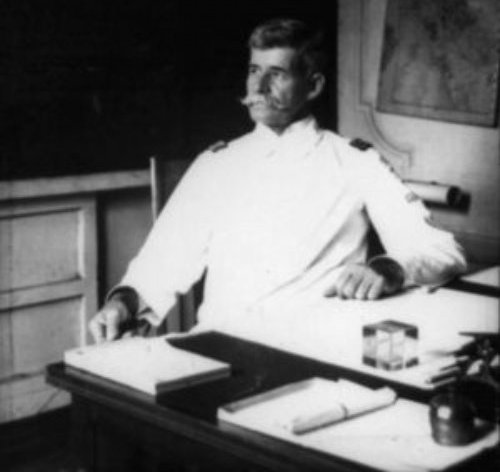
On March 10, 1899, he arrived in Manila on the transport Grant with 42 officers and 1,716 men.

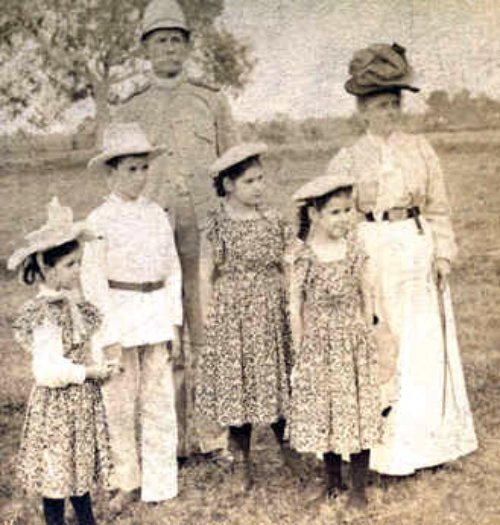
Lawton captured Santa Cruz, Laguna Province and San Isidro, Nueva Ecija Province during his first three months. On June 10, 1899, he began his Cavite campaign which pushed the Filipino line far back from Manila on the south. In October 1899 a successful campaign against the main force of Aguinaldo began.
Lawton’s position is marked by a star

On Dec. 19, 1899, he faced the men of Gen. Licerio Geronimo at San Mateo, Morong Province. Lawton’s force consisted of Troop I of the Fourth Cavalry, 2nd and 3rd Squadrons of the Eleventh Cavalry U.S.V., and one battalion each of the 27th Infantry Regiment U.S.V. and 29th Regular Infantry Regiment.
Lawton believed in leading from the front, continuing a style he had employed since his years in the Civil War. His subordinates were constantly worried that he needlessly exposed himself to hostile gunfire, but Lawton refused to observe from the rear, or to take cover.
At about 9:15 am, General Lawton was walking along the firing line within 300 yards of a small Filipino trench, conspicuous in the big white helmet he always wore and a light yellow raincoat. He was also easily distinguishable because of his commanding 6’3″ stature.
The Filipinos directed several close shots which clipped the grass nearby. His staff officer called General Lawton’s attention to the danger he was in, but he only laughed.
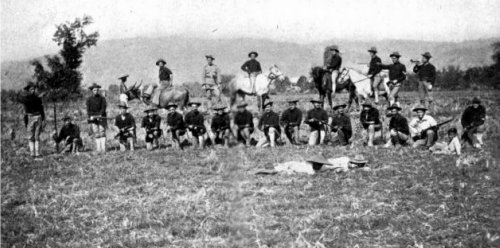
Suddenly Lawton exclaimed:
“I am shot!” and fell dead into the arms of a staff officer.

Bonifacio Mariano was credited with the kill. A street in San Mateo was named in his honor.
At 11:00 am, the Americans successfully crossed the river and drove the Filipinos from San Mateo. Thirteen Americans were wounded; the US Army reported 40 Filipinos killed and 125 wounded.
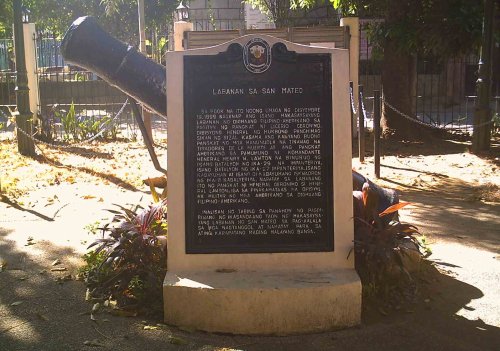
Before his death, Lawton had written about the Filipinos in a formal correspondence, “Taking into account the disadvantages they have to fight against in terms of arms, equipment and military discipline, without artillery, short of ammunition, powder inferior, shells reloaded until they are defective, they are the bravest men I have ever seen…”
Gen. Licerio Geronimo: Nemesis of General Henry Lawton
Gen. Licerio Geronimo commanded the Filipino force that killed Maj. Gen. Henry Ware Lawton at the battle of San Mateo on Dec. 19, 1899.
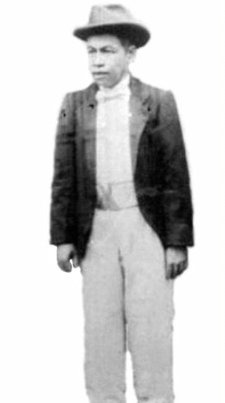
Ger�nimo was born to Graciano Geronimo and Flaviana Imaya in Samp�loc district, Manila on Aug. 27, 1855. (LEFT, Geronimo in 1904, pic courtesy of David Banaghan).
His father hailed from Montalban, Morong Province (now Rodriguez, Rizal Province) and his mother was a native of Gapan, Nueva Ecija Province.
When he was nine, he lived with his grandfather in a farm in San Miguel de Mayumo, Bulacan Province. At 14, he joined his father in Montalban where he helped in farm chores. Due to poverty, Geronimo did not enjoy the benefits of formal education. But he learned how to read and write with the help of a friend who taught him the alphabet.
He married twice; his first marriage to Francisca Reyes ended with her death. His second wife was Cayetana Lincaoco of San Mateo, who bore him five children. He earned a living by farming, and by working as a boatman on the Marikina and Pasig rivers, transporting passengers to and from Manila.
Geronimo was recruited into the secret revolutionary society Katipunan by his godfather, Felix Umali, alguacil mayor of barrio Wawa, Montalban.
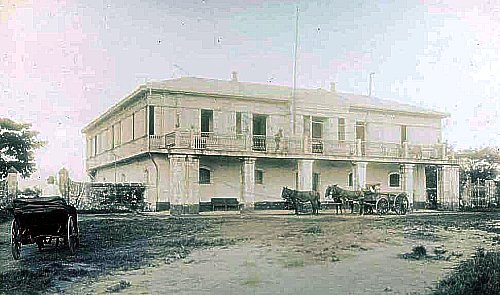
Geronimo was part of the rebel group that assaulted the El Deposito (water reservoir) and Polvorin (gunpowder depot) in San Juan del Monte on Aug. 30, 1896. He organized Katipunan forces under his command in the towns of Montalban, San Mateo, and Marikina, all in Morong Province. His forces first served under General Francisco Makabulos in San Rafael, Bulacan and later under General Mariano Llanera during military operations against the Spaniards in San Miguel de Mayumo, Bulacan, and Cabanatuan, Nueva Ecija.
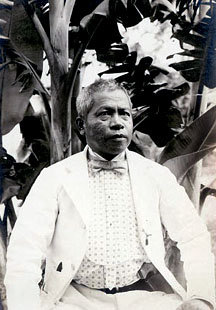
When the Truce of Biyak-na-Bato of Dec. 14, 1897 temporarily brought peace, he retired to his farm in Montalban. After the Americans smashed the Spanish fleet in Manila Bay on May 1, 1898, he allowed the Spaniards to assign him as a commandant in the Milicia Territorial, formed to resist the Americans on land.
On May 19, 1898, Aguinaldo returned from exile in Hongkong and resumed the war against Spain. Geronimo deserted the colonial Milicia and rejoined his revolutionary comrades. On Nov. 28, 1898, he returned to his post as division general of the Philippine army in Morong.
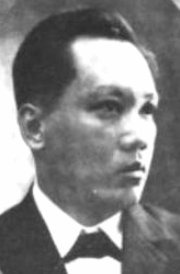
Arturo Dancel (RIGHT, in 1903), a member of the pro-American Partido Federal, convinced Geronimo to surrender; on March 30, 1901 he gave up in San Mateo with 12 officers, 29 men and 30 guns. He initially surrendered to Capt. Duncan Henderson, CO of Company E, 42nd Infantry Regiment of U.S. Volunteers, who presented him to Col. J. Milton Thompson, the regimental commander. Shortly afterward, Geronimo joined the Partido Federal.

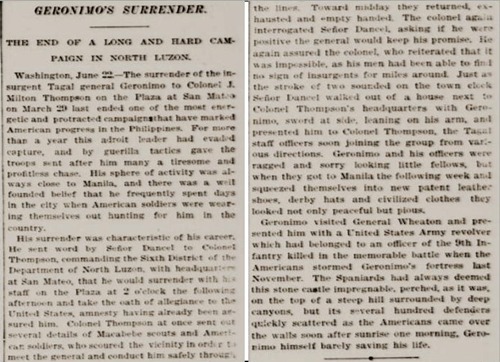

He left the constabulary on May 16, 1904 and returned to work his farm in Barrio San Rafael, Montalban.
Geronimo (LEFT, in his 60’s, pic courtesy of Macky Hosalla) died on Jan. 16, 1924. He was 68 years old. Barangay Geronimo, Geronimo Park and General Licerio Ger�nimo Memorial National High School in Rodriguez, Rizal, as well as a street in Samp�loc, Manila, were named in his honor.
